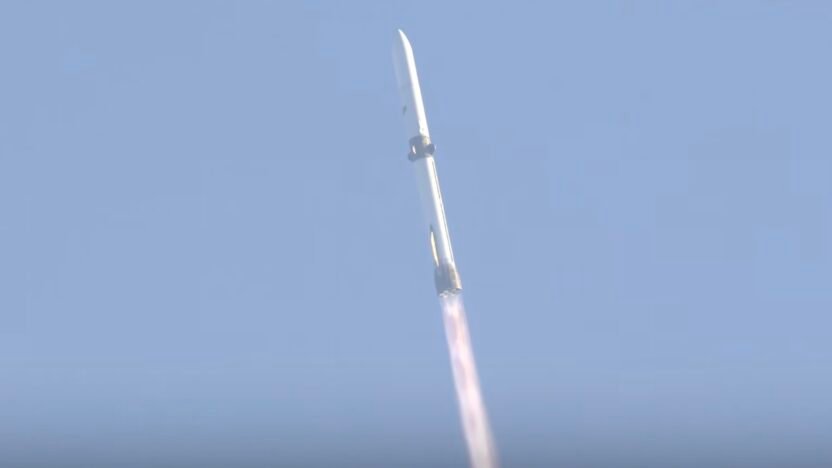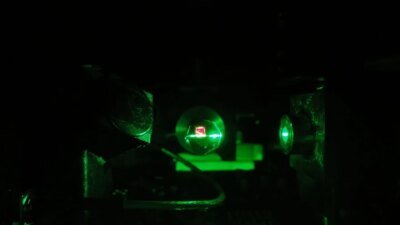WASHINGTON — Blue Origin successfully launched a NASA Mars mission on the second flight of its New Glenn booster Nov. 13, landing the vehicle’s first stage in the process.
New Glenn lifted off on the NG-2 mission at 3:55 p.m. Eastern from Launch Complex 36 at Cape Canaveral Space Force Station in Florida. The liftoff took place after a first attempt nearly an hour earlier was halted 20 seconds before liftoff for an undisclosed technical reason.
The launch was originally scheduled for Nov. 9 but scrubbed because of weather conditions. The company also reported a technical issue with ground support equipment at the pad during that attempt, and it was not clear that was resolved in time for launch if weather had been acceptable. Blue Origin called off a Nov. 12 launch attempt, citing elevated solar activity.
The booster’s first stage shut down its seven BE-4 engines and separated from the upper stage a little more than three minutes after liftoff, then attempted a landing on Blue Origin’s landing ship, Jacklyn, in the Atlantic Ocean. The stage performed a reentry and landing burn, touching down on the deck of Jacklyn 9 minutes and 15 seconds after liftoff.
This was the first successful landing of the New Glenn first stage. The company attempted a landing on the inaugural launch, NG-1, but the stage’s engines failed to relight.
The primary payload for NG-2 was NASA’s Escape and Plasma Acceleration and Dynamics Explorers (ESCAPADE) mission, a pair of small satellites that will go to Mars to study space weather conditions there. The twin spacecraft separated about 30 seconds apart a little more than 33 minutes after liftoff, after a second burn of the New Glenn upper stage.
The launch also carried a secondary payload from Viasat to test communications technologies for NASA’s Communications Services Project, which aims to shift from NASA-run relay systems to commercial networks. That payload remained attached to the upper stage.
The twin ESCAPADE spacecraft, Blue and Gold, were built by Rocket Lab. Each spacecraft, about a meter on a side, weighed 535 kilograms fully fueled at launch.
Dave Curtis, ESCAPADE project manager, said at a Nov. 8 briefing that the mission team would spend the days after the launch commissioning the spacecraft. A key maneuver is scheduled for 14 days after launch to place the spacecraft on a trajectory to the Earth-sun L2 Lagrange point 1.5 million kilometers from Earth.
The spacecraft will be spending the next year loitering around the point in an orbit shaped like a kidney bean before returning to Earth in late 2026 for a maneuver to send the spacecraft to Mars. The spacecraft will arrive at Mars in September 2027.
Initial spacecraft operations will be handled by Rocket Lab at its Long Beach, California, facility, Curtis said. After commissioning is complete, spacecraft operations will shift to the University of California Berkeley.

ESCAPADE and the goal of low-cost planetary science missions
The launch is the culmination of years of effort to develop ESCAPADE. NASA selected the mission, along with the Janus asteroid flyby spacecraft and Lunar Trailblazer orbiter, in 2019 as part of its SIMPLEx line of low-cost planetary science missions.
ESCAPADE was originally designed to go to Mars as a second payload on the launch of the Psyche asteroid mission. Changes in the flight plan for Psyche, including a switch from a Falcon 9 to a Falcon Heavy, no longer made it feasible for ESCAPADE to go into Mars orbit.
The project redesigned the mission, working with Rocket Lab to develop the twin spacecraft. NASA selected Blue Origin in early 2023 to launch the spacecraft on New Glenn, a launch then planned for late 2024.
ESCAPADE was manifested on the first New Glenn, but NASA decided in September 2024 to remove the spacecraft from that NG-1 launch because the rocket was unlikely to be ready in time before the launch window closed in late October. NG-1 launched in January 2025 with a Blue Origin demonstration payload that remained attached to the upper stage.
The rescheduled launch of ESCAPADE now, roughly halfway between traditional launch windows that are available only about every two years, was made possible through a revised trajectory developed by Advanced Space that will send ESCAPADE first to the Earth-sun L2 point.
“That L2 loiter planning drove a lot of risk assessment,” said Richard French, vice president of business development and strategy at Rocket Lab, at a Nov. 8 briefing. That included assessment of additional maneuvers, the thermal environment and radiation exposure. “As a team, we agreed that risk was acceptable and within the capabilities of the spacecraft that we built.”
Rob Lillis, principal investigator (PI) for ESCAPADE at the University of California Berkeley Space Sciences Lab, said NASA also accepted a higher risk presented by the additional time in space, calling it “consistent with the Class D approach of this mission.” Class D missions at NASA are willing to take more risk, trading that off typically with decreased costs.
“This is certainly a risk that we were willing to take given that we’re going to be doing some great science,” he added, noting the spacecraft have a design life of at least three years and the mission can achieve its science goals in one year at Mars.
That science involves studying space weather at Mars, including how the solar wind interacts with the planet’s magnetosphere and atmosphere. The twin spacecraft will initially go into the same orbit around Mars, separated by between 2 and 30 minutes. Lillis said that will allow scientists to characterize changing conditions on much shorter timescales than previous missions have been able to do.
In the second phase of the mission, the two spacecraft will move into separate orbits. That will allow ESCAPADE “to get that cause and effect, to see that real-time response to space weather events,” he said.
The data from ESCAPADE will offer an “unprecedented stereo viewpoint” on space weather at Mars, he said, which could help scientists understand how the planet lost its atmosphere and thus changed its climate. The data could also help planning for future robotic and human missions with better information about space weather conditions.
ESCAPADE is also a pathfinder for a different model for planetary missions. “Our spacecraft, built in combination with this university PI-led mission,” said French, “demonstrates the potential for decadal-class planetary science at a fraction of the traditional cost and on a much shorter schedule.”
“It is a validation of the SIMPLEx program mission model using fixed-price contracting, and we do believe this can bring portfolio balance” to NASA’s planetary science division, he said.
ESCAPADE’s cost is in the “$60 million category,” said Curtis, but deferred to NASA for the overall mission cost. NASA did not participate in the Nov. 8 briefing, organized by Blue Origin, because of the ongoing government shutdown. He said the launch delay from 2024 cost $5 million to $7 million.
A success for ESCAPADE would offset failures of previous SIMPLEx missions. Janus was canceled by NASA in 2023 when delays in the Psyche launch prevented Janus from carrying out its asteroid flyby mission. Lunar Trailblazer failed shortly after its launch in February. Two earlier cubesat-class SIMPLEx missions, LunaH-Map and Q-PACE, also failed after their launches.
“It is just an amazing day,” Nicky Fox, NASA associate administrator for science, said before the Nov. 9 launch attempt on Blue Origin’s webcast, noting the mission was the first NASA use of New Glenn as well as the first NASA Mars heliophysics mission. “We waited a long time for this.”




